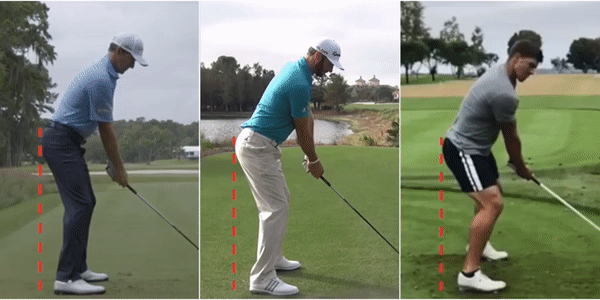IMPROVE MY GAME
Articles
Why Early Extension Causes a Reduction of Power in the Golf Swing
Early extension is one of the most common swing characteristics among amateur golfers. We define early extension as excessive movement of the pelvis towards the ball (target line) during the swing. Though we often associate early extension with a loss of consistency, the loss of power is just as significant. Here's Dr. Greg Rose describing the relationship between early extension, centripetal force and power in the golf swing:
Centripetal force is defined as "a force that acts on a body moving in a circular path and is directed toward the center around which the body is moving."
The concept of centripetal force is ubiquitous in sports, especially rotational activities. Watch how a hammer thrower accelerates the implement by remaining centered in the ring. This is a great illustration of centripetal force.

So how does centripetal force apply to the golf swing?
Below are three elite golfers DTL: Jimmy Walker (left), Dustin Johnson (center), and World Long Drive champ Justin James (right). A vertical line is drawn behind their tailbone as a reference point. As you can see, Jimmy Walker (the shortest hitter) moves off the line, while DJ's hips stay on the line and Justin's actually move past the line (away from the target line).

Jimmy Walker isn't a short hitter by any means, but he's forced to rely on his wrist angle to keep up with the longest in golf. Put it this way: turn on a World Long Drive event and watch the lower bodies. They always always move away from the target line like Justin James. This is a great illustration of a phenomenon called parametric acceleration. By pulling inward at the impact stage, James is able to create additional acceleration of the club.
Understanding the physical and technical strategies related to creating speed in rotational sports is the whole purpose behind our Power Level 2 course (hosted at TPI HQ on March 14 - 15). More distance isn't just about being physically stronger, it's about being more technically efficient. We've written about this a number of times in the past.
We're careful to refer to early extension as a swing characteristic and not a swing fault because it doesn't preclude players from playing great golf. Early extension hasn't stopped Zach Johnson and Jimmy Walker from winning major championships, flying private and paying cash for large homes. That said, early extension requires golfers to make compensations at impact (just look at how Zach addresses the ball on the toe of his driver).
Every single golfer wants more speed, but some won't have the patience to train for it. That's totally fine. We didn't create TPI to get golfers in the gym, we created TPI so that a coach could identify their student's needs and make an appropriate recommendation. As a coach, it's important to understand how your technical recommendations are contributing to speed in the swing. Some golfers early extend because of a technical inefficiency, others early extend because it's the most effective way for them to swing based on their physical tools. Either way, your student can be a good golfer with early extension, but it might prevent others from reaching their power potential.
